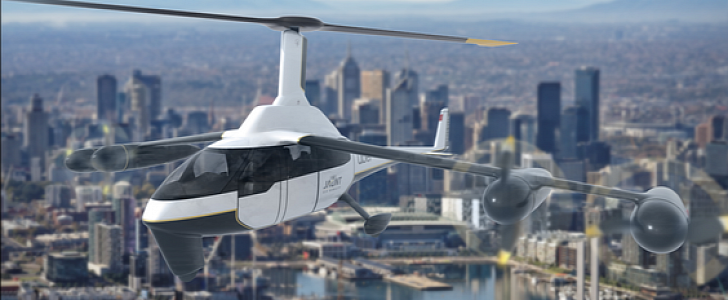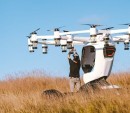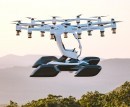Sometimes, you have to look to the past for ideas that will carry you into the future. Jaunt Air Mobility is doing just that with its eVTOL prototype, Journey, officially unveiled to the public at the end of last year.
Estimates say that the U.S. passenger eVTOL (Electric Vertical Take-Off and Land vehicle) market will reach $3.4 billion in 2025, as more companies will be focusing their efforts on getting people in the air to avoid congestion and pollution. Jaunt Air Mobility was made a Uber Elevate Partner in June 2019 and has been working diligently on a prototype.
The goal is to have Journey ready and submitted for certification in 2023, and then up in the air for ride-share services in 2025, through Uber Elevate. Journey is fully electric and strapped with plenty of tech, but it’s actually based on an aircraft model that’s been around for decades: the gyrocopter.
Journey comes with a patented design and Reduced rotor Operating Speed (ROSATM) technology, which reduces rotor speed in cruise mode for a more silent, more efficient flight. The company’s patented “LevelFly” solution keeps the cabin of the aircraft level as the mast tilts forward on takeoff and backwards during landing. This is also known as the gyrocopter effect, and requires objects in the cabin to be tied down to prevent damage.
“We can guarantee that you will never spill your martini when riding in a Jaunt Journey because it takes off vertically, transitions to fly like a plane and then lands vertically,” Kaydon Stanzione, CEO of Jaunt Air Mobility tells the Robb Report in a recent interview. “It’s LevelFly all the way.”
Described as a compound aircraft, Journey combines technology from helicopters and fixed winged aircraft, powered by electric motors. It is described as fast and reliable, and very environmentally-friendly, and will be able to cruise at speeds of 175 mph, carrying four passengers and the pilot. Jaunt says it’s also quieter than traditional helicopters, in keeping with Uber Elevate’s rigorous demands in this respect.
As of the time of writing, testing of Journey includes over 100 hours of flight, with over 1,000 takeoffs and landings.
The goal is to have Journey ready and submitted for certification in 2023, and then up in the air for ride-share services in 2025, through Uber Elevate. Journey is fully electric and strapped with plenty of tech, but it’s actually based on an aircraft model that’s been around for decades: the gyrocopter.
Journey comes with a patented design and Reduced rotor Operating Speed (ROSATM) technology, which reduces rotor speed in cruise mode for a more silent, more efficient flight. The company’s patented “LevelFly” solution keeps the cabin of the aircraft level as the mast tilts forward on takeoff and backwards during landing. This is also known as the gyrocopter effect, and requires objects in the cabin to be tied down to prevent damage.
“We can guarantee that you will never spill your martini when riding in a Jaunt Journey because it takes off vertically, transitions to fly like a plane and then lands vertically,” Kaydon Stanzione, CEO of Jaunt Air Mobility tells the Robb Report in a recent interview. “It’s LevelFly all the way.”
Described as a compound aircraft, Journey combines technology from helicopters and fixed winged aircraft, powered by electric motors. It is described as fast and reliable, and very environmentally-friendly, and will be able to cruise at speeds of 175 mph, carrying four passengers and the pilot. Jaunt says it’s also quieter than traditional helicopters, in keeping with Uber Elevate’s rigorous demands in this respect.
As of the time of writing, testing of Journey includes over 100 hours of flight, with over 1,000 takeoffs and landings.










